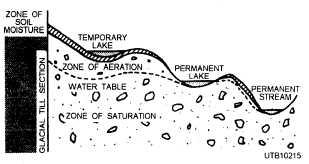composing any stratum to transmit water under pressure is called its "permeability." The property of the material of any stratum to contain interstices, or openings, is called its "porosity." Both the permeability and porosity of the rock formation determine whether groundwater can be found in suitable amounts at any particular location.
When water falls on the ground, the part of it that becomes groundwater by reason of the soil or surface characteristics is absorbed into the earth. It is then either held in suspension or flows downward by gravity to a point beyond which it cannot pass. It then flows in any direction provided the permeability of the particular stratum holding it permits. When the permeability of the stratum does not permit flow, the water remains confined at that point. As more water percolates downward through the soil or rock, the top level of the confined water rises until flow becomes possible in one direction or the other through a more permeable formation. More water must come from a higher level to sustain such a flow. Finally, the amount of water percolating from the higher levels balances the amount of water flowing laterally away, and the top level of the main body of groundwater is stabilized. The upper surface of this main body of groundwater, when stabilized under any condition of flow, constitutes the water table for any specific locality. However, the water table is not fixed because it rises and falls according to the varying amounts of water percolating from above (called the "influent" supply) and those amounts flowing away or withdrawn (called the "effluent" flow). A stratum that bears groundwater is termed an aquifer.
Water beneath the surface of the earth occurs in three zones (fig. 7-2) as follows:
1. The zone of soil moisture is where water is temporarily held in pore spaces by capillarity and other soil conditions. Water in the zone of soil moisture may evaporate directly or through transpiration by plants or it may percolate downward into the zone of aeration and then to the zone of saturation.
2. The zone of aeration, or zone of percolation, is beneath the soil layer where both water and air are present in the pore spaces. Wells ending in the zone of aeration produce no water. Sometimes in the cooling- off process or because of other external and internal influences, a stratum of material that does not permit the passage of water has been heaved about into a cup- shaped formation at a point in the zone of aeration higher than the established water table. In time, this cup is filled with groundwater and a "perched" or false water table is established. This is a serious problem to those attempting to develop a groundwater supply. The perched supply, if pumped, is soon exhausted and requires seepage from above for replenishment. Many of these perched supplies result from folded clay formations in the zone of aeration that stop the percolation of water downward. Perched water never forms a dependable water supply.
3. The zone of saturation is where all pore spaces are filled with water. The top of the saturated zone is called the "water table." It is not flat, but has a variable depth beneath the surface, depending upon surface topography, rainfall, and direction of water movement, rock structure, and porosity. Permeable rocks in the zone of saturation yield water to wells.
Q1. What are the two categories of water?
Q2. What are the three zones of subsurface groundwater?
THE QUALITY OF WATER
LEARNING OBJECTIVE: Identify and understand types of waterborne diseases, impurities in water, and types of treatment processes.
Preliminary to discussion of water production, the "quality" of available water supplies must be briefly considered. Whether the water supply comes from the surface or underground, the supply must suit its intended use. Either source may produce water with too high a concentration of mineral salts, color, suspended matter, incrusting or corrosive agents, or bacteria that prevents the use of water in its natural state for the purpose intended. If suitable water cannot be found, then other available sources must be used. The water must be treated to remove those elements that make its direct use impossible. For human consumption, all harmful bacteria must be destroyed and the concentration of certain mineral salts and

Figure 7-2. - Classification of underground water.
Continue Reading